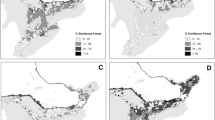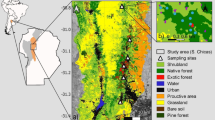Abstract
Our understanding of why tropical forest species differ in their ability to inhabit agroecosystems is limited, despite the link between this ability and the likelihood of population decline for species inhabiting regions undergoing widespread conversion of forest to agriculture. We used logistic regression and data from southern Costa Rica to develop a model based on natural history characteristics to distinguish between forest species that did or did not use agricultural land covers. We sampled birds along 15 3.0-km routes, seven in forest and eight in agriculture, five times over three years. Each species was classified as an F-species, detected only in forest, a G-species, detected in both forest and agriculture, or an A-species, detected only in agriculture. Thirty percent of species were F-species, 42% were G-species, and 28% were A-species. Based on the logistic regression model, the likelihood of being a G-species, as opposed to an F-species, was low for species that were dependent on forest interior, had a stenophagous diet, and a small elevational range. Weight, resident versus migrant status, and whether or not a species was insectivorous, were not significant predictors of being a G-species. For all F–G species pairs, the model correctly predicted the G-species 70% of the time. The model provides a first step in identifying those characteristics that predispose forest species to use agricultural land. In addition, our results indicate that the structurally simple agricultural systems of the study region are of limited value for a large proportion of the regional species pool.
Similar content being viewed by others
References
American Ornithologist's Union 1998. Checklist of North American Birds. 7th edn. AOU, Washington, DC.
American Ornithologist's Union 2000. Forty-second supplement to the American Ornithologist's Union Checklist of North American Birds. The Auk 117: 847–858.
American Ornithologist's Union 2002. Forty-third supplement to the American Ornithologist's Union Checklist of North American Birds. The Auk 119: 897–906.
Andrade G.I. and Rubio-Torgler H. 1994. Sustainable use of the tropical rain forest: evidence from the avifauna in a shifting-cultivation habitat mosaic in the Colombian Amazon. Conservation Biology 8: 545–554.
Blake J.G. and Loiselle B.A. 2001. Bird assemblages in second-growth and old-growth forests, Costa Rica: perspectives from mist nets and point counts. The Auk 118: 304–326.
Bowman D.M.J.S., Woinarski J.C.Z., Sands D.P.A., Wells A. and McShane V.J. 1990. Slash-and-burn agriculture in the wet coastal lowlands of Papua New Guinea: response of birds, butterflies and reptiles. Journal of Biogeography 17: 227–239.
Canaday C. 1996. Loss of insectivorous birds along a gradient of human impact in Amazonia. Biological Conservation 77: 63–77.
Confer J.L. and Holmes R.T. 1995. Neotropical migrants in undisturbed and human-altered forests of Jamaica. The Wilson Bulletin 107: 577–814.
Cohen E.B. and Lindell C.A. Survival, habitat use, and movement of fledgling robins in a Costa Rican agricultural landscape. The Auk, in press.
Conway C.J., Powell G.V.N. and Nichols J.D. 1995. Overwinter survival of Neotropical migratory birds in early-successional and mature tropical forests. Conservation Biology 9: 855–864.
Desrochers A. and Hannon S.J. 1997. Gap crossing decisions by forest songbirds during the post-fledging period. Conservation Biology 11: 1204–1210.
Estrada A., Coates-Estrada R. and Meritt Jr. D.A. 1997. Anthropogenic landscape changes and avian diversity at Los Tuxtlas, Mexico. Biodiversity and Conservation 6: 19–43.
Ford H.A., Barrett G.W., Saunders D.A. and Recher H.F. 2001. Why have birds in the woodlands of Southern Australia declined? Biological Conservation 97: 71–88.
Gillespie T.W. 2001. Application of extinction and conservation theories for forest birds in Nicaragua. Conservation Biology 15: 699–709.
Greenberg R., Bichier P., Cruz Angon A. and Reitsma R. 1997a. Bird populations in shade coffee plantations in central Guatemala. Conservation Biology 11: 448–459.
Greenberg R., Bichier P. and Sterling J. 1997b. Bird populations in rustic and planted shade coffee plantations of eastern Chiapas, Mexico. Biotropica 29: 501–514.
Greenslade P.J.M. 1983. Adversity selection and the habitat templet. American Naturalist 122: 352–365.
Grime J.P. 1977. Evidence for the existence of three primary strategies in plants and its relevance to ecological and evolutionary theory. American Naturalist 111: 1169–1194.
Harris R.J. and Reed J.M. 2002. Behavioral barriers to non-migratory movements of birds. Annales Zoologici Fennici 39: 275–290.
Hartshorn G.S. 1980. Neotropical forest dynamics. Biotropica 12: 23–30.
Hayes F.E., Trimm N.A., Sanasie B. and Ffrench R.P. 2000. Breeding biology of the White-tailed Sabrewing at Tobago, West Indies. Journal of Field Ornithology 71: 597–605.
Holl K.D. 1999. Factors limiting tropical rain forest regeneration in abandoned pasture: seed rain, seed germination, microclimate, and soil. Biotropica 31: 229–242.
Holl K.D. 2002. Effects of shrubs on tree seedling establishment in an abandoned tropical pasture. Journal of Ecology 90: 179–187.
Hosmer D.W. and Lemeshow S. 2000. Applied Logistic Regression, 2nd edn. John Wiley and Sons, New York.
Houghton R.A. 1994. The worldwide extent of land-use change. Bioscience 44: 305–313.
Johns A.D. 1991. Responses of Amazonian rain forest birds to habitat modification. Journal of Tropical Ecology 7: 417–437.
Johnson M.D. and Sherry T.W. 2001. Effects of food availability on the distribution of migratory warblers among habitats in Jamaica. Journal of Animal Ecology 70: 546–560.
Karr J.R., Robinson S.K., Blake J.G. and Bierregaard Jr. R.O. 1990. Birds of four neotropical forests. In: Gentry A.H. (ed) Four Neotropical Forests. Yale University Press, New Haven, Connecticut, pp. 237–269.
Kattan G.H., Alvarez-López H. and Giraldo M. 1994. Forest fragmentation and bird extinctions: San Antonio eight years later. Conservation Biology 8: 138–146.
Kuban J.F. and Neill R.L. 1980. Feeding ecology of hummingbirds in the highlands of the Chisos Mountains, Texas, USA. The Condor 82: 180–185.
Lindell C.A. and Smith M.L. 2003. Nesting bird species in sun coffee, pasture, and understory forest in southern Costa Rica. Biodiversity and Conservation 12: 423–440.
Lips K.R. 1998. Decline of a tropical montane amphibian fauna. Conservation Biology 12: 106–117.
MAB 1990. Costa Rica. In: Man and Biosphere Reserves, Compilation 5. IUCN, Cambridge, UK, pp. 55–59.
Manger W.F. 1992. Colonization on the southern frontier of Costa Rica: a historical-cultural landscape. M.S. Thesis, Memphis State University, Memphis, Tennessee.
Moguel P. and Toledo V.M. 1999. Biodiversity conservation in traditional coffee systems of Mexico. Conservation Biology 13: 11–21.
Myers N., Mittermeier R.A., Mittermeier C.G., da Fonseca G.A.B. and Kent J. 2000. Biodiversity hotspots for conservation priorities. Nature 403: 853–858.
Nepstad D.C., Uhl C. and Serrão E.A.S. 1991. Recuperation of a degraded Amazonian landscape: forest recovery and agricultural restoration. Ambio 20: 248–255.
Salati E. and Nobre C.A. 1991. Possible climatic impacts of tropical deforestation. Climatic Change 19: 177–196.
Olson D.M. and Dinerstein E. 1998. The global 200: a representation approach to conserving the Earth's most biologically valuable ecoregions. Conservation Biology 12: 502–515.
Perfecto I., Rice R.A., Greenberg R. and Van der Voort M.E. 1996. Shade coffee: a disappearing refuge for biodiversity. Bioscience 46: 598–607.
Petit L.J. and Petit D.R. 2003. Evaluating the importance of human-modified lands for Neotropical bird conservation. Conservation Biology 17: 687–694.
Raman T.R.S., Rawat G.S. and Johnsingh A.J.T. 1998. Recovery of tropical rainforest avifauna in relation to vegetation succession following shifting cultivation in Mizoram, north-east India. Journal of Applied Ecology 35: 214–231.
Rappole J.H., McShea W.J. and Vega-Rivera J. 1993. Evaluation of two survey methods in upland avian breeding communities. Journal of Field Ornithology 64: 55–70.
Restrepo C., Gomez N. and Heredia S. 1999. Anthropogenic edges, treefall gaps, and fruit-frugivore interactions in a Neotropical montane forest. Ecology 80: 668–685.
Rice R.A. and Ward J.R. 1996. Coffee, conservation, and commerce in the western hemisphere. Natural Resources Defense Council and Smithsonian Migratory Bird Center, Washington, DC.
Rice W.R. 1989. Analyzing tables of statistical tests. Evolution 43: 223–225.
Ricketts T.H., Daily G.C. and Ehrlich P.R. 2001. Countryside biogeography of moths in a fragmented landscape: biodiversity in native and agricultural habitats. Conservation Biology 15: 378–388.
Robbins C.S., Dawson D.K. and Dowell B.A. 1995. Changing land use: problems and opportunities. Maine Agricultural and Forest Experiment Station, Miscellaneous Publication 727: 1–14.
Roberts D.L., Cooper R.J. and Petit L.J. 2000. Use of premontane moist forest and shade coffee agroecosystems by army ants in western Panama. Conservation Biology 14: 192–199.
SAS 2001. Version 8.2. SAS Institute, Inc., Cary, North Carolina.
Sánchez-Azofeifa G.-A. 1996. Assessing land use/cover change in Costa Rica. Ph.D. Thesis, University of New Hampshire, Durham, New Hampshire.
Sekercioglu C.H., Ehrlich P.R., Daily G.C., Aygen D., Goehring D. and Sandí R.F. 2002. Disappearance of insectivorous birds from tropical forest fragments. Proceedings of the National Academy of Science USA 99: 263–267.
Sieving K.E., Willson M.F. and DeSanto T.L. 1996. Habitat barriers to movement of understory birds in fragmented south-temperate rainforest. The Auk 113: 944–949.
Sisk T.D. 1992. Distribution of birds and butterflies in heterogeneous landscapes. Ph.D. Thesis, Stanford University, Palo Alto, California.
Skole D.L., Chomentowski W.H., Salas W.A. and Nobre A.D. 1994. Physical and human dimensions of deforestation in Amazonia. Bioscience 44: 314–322.
Sokal R.R. and Rohlf F.J. 1995. Biometry. 3rd edn. W.H. Freeman and Co., New York.
Southwood T.R.E. 1988. Tactics, strategies and templets. Oikos 52: 3–18.
St. Clair C.C., Bélisle M., Desrochers A. and Hannon S. 1998. Winter resources of forest birds to habitat corridors and gaps. Conservation Ecology 2: 13. Available on the internet at http://www.consecol.org/vol2/iss2/art13.
Stiles F.G. 1980. Evolutionary implications of habitat relations between permanent and winter resident landbirds in Costa Rica. In: Keast A. and Morton E.S. (eds) Migrant Birds in the Neotropics: Ecology, Behavior, Distribution, and Conservation. Smithsonian Institution Press, Washington, DC, pp. 421–435.
Stiles F.G. 1983. Birds. In: Janzen D.H. (ed) Costa Rican Natural History. The University of Chicago Press, Chicago, Illinois, pp. 502–544.
Stiles F.G. 1985. Conservation of forest birds in Costa Rica: problems and perspectives. In: Diamond A.W. and Lovejoy T.E. (eds) Conservation of Tropical Forest Birds. Proceedings of a Workshop and Symposium, XVIII World Conference of the International Council for Bird Preservation, Kings College, Cambridge, UK, 7, 8, and 10 August 1992. ICBP Technical Publication No. 4, Cambridge, UK, pp. 141–168.
Stiles F.G. 1995. Behavioral, ecological and morphological correlates of foraging for arthropods by the hummingbirds of a tropical wet forest. The Condor 97: 853–878.
Stiles F.G. and Skutch A.F. 1989. A Guide to the Birds of Costa Rica. Cornell University Press, Ithaca, New York.
Stotz D.F., Fitzpatrick J.W., Parker T.A. III and Moskovits D.K. 1996. Neotropical Birds: Ecology and Conservation. The University of Chicago Press, Chicago, Illinois.
Stouffer P.D. and Bierregaard Jr. R.O. 1995. Effects of forest fragmentation on understory hummingbirds in Amazonian Brazil. Conservation Biology 9: 1085–1094.
Terborgh J. and Weske J.S. 1969. Colonization of secondary habitats by Peruvian birds. Ecology 50: 765–782.
Thiollay J.-M. 1995. The role of traditional agroforests in the conservation of rain forest bird diversity in Sumatra. Conservation Biology 9: 335–353.
Wilson E.O. 1992. The Diversity of Life. W.W. Norton and Co., New York.
Wilson E.O. and Willis E.O. 1975. Applied biogeography. In: Cody M.L. and Diamond J.R. (eds) Ecology and Evolution of Communities. Harvard University Press, Cambridge, Massachusetts, pp. 522–533.
Wunderle Jr. J.M. and Latta S.C. 1996. Avian abundance in sun and shade coffee plantations and remnant pine forest in the Cordillera Central, Dominican Republic. Ornitología Neotropical 17: 19–34.
Wunderle Jr. J.M. and Waide R.B. 1993. Distribution of overwintering nearctic migrants in the Bahamas and Greater Antilles. The Condor 95: 904–933.
Author information
Authors and Affiliations
Rights and permissions
About this article
Cite this article
Lindell, C.A., Chomentowski, W.H. & Zook, J.R. Characteristics of bird species using forest and agricultural land covers in southern Costa Rica. Biodiversity and Conservation 13, 2419–2441 (2004). https://doi.org/10.1023/B:BIOC.0000048446.79935.6f
Issue Date:
DOI: https://doi.org/10.1023/B:BIOC.0000048446.79935.6f




